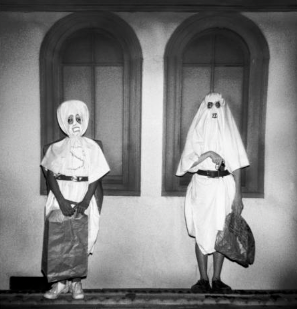DEAD IN BLACK & WHITE

1981 'Ghosts & Gun' 127 Kodak Brownie, silver halide
The collective consciousness of Halloween has a worldwide history In Latin American countries, the living welcome the dead. Several concepts define this celebration. The Celtics believed that the gate to fairyland opened for mortals on Halloween night. As early as the 15th century, Fairies (gods reduced to small supernatural imps) were reported to visit humans. Humans could then enter the fairy realm and never leave. Western Europe had different reasons to celebrate. In the 1600s, Day. London survived a plot to blow up the House of Lords. People dressed as victims of the explosion with bonfires symbolizing the explosion, Kids dressed in rags with smeared charcoal on their faces. The would celebrate going from house to house offering a performance, (a 'trick), in exchange for a 'treat'.
In the mid-1800s, the potato famine led to the emigration of over a million immigrants to America. Settlers from several countries brought beliefs about Halloween. America paid no mind to historical reasons behind Halloween, but continued a celebration. Now redefined, hallowen represents a time that people are united by a shared sense of fun and celebration, regardless of color, age, ethnicity, or sexual orientation. People portray news stories, politics, current events, musicians, or anything that suggests enforced or suggested beliefs. Halloween has prankster participants, sexual enticers, artists mimicking rockstars, and killers from past horror movies, the devil, etc. The people are 'trick', their delivery is 'treat'?
